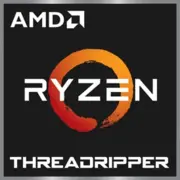AMD Ryzen Threadripper 3970X

AMD Ryzen Threadripper 3970X: A Processor for Professionals in 2025
Review, Specifications, and Build Tips
Key Specifications: Architecture and Performance
The AMD Ryzen Threadripper 3970X processor, released in 2019, is still in high demand in professional settings due to its unique combination of cores and technologies.
Architecture and Manufacturing Process
- Codename: Castle Peak (Zen 2).
- Manufacturing Process: TSMC 7nm FinFET — an energy-efficient platform allowing for 32 cores and 64 threads without significant overheating.
- Cache Memory: 128 MB L3 Cache, which speeds up processing of large data sets (e.g., rendering 3D scenes).
- TDP: 280 W — high power consumption requires robust cooling solutions.
Performance
- Geekbench 6: Single-Core — 1635, Multi-Core — 14072. For comparison, the modern Ryzen 9 7950X (2025) scores around ~2200/25000, but Threadripper retains an edge in tasks involving extreme parallelism.
- Key Features:
- Support for PCIe 4.0 (64 lanes) — ideal for connecting multiple GPUs or NVMe drives.
- Precision Boost 2 and Extended Frequency Range (XFR) for automatic overclocking.
Compatible Motherboards: Selection and Features
The Threadripper 3970X utilizes the sTRX4 socket, which is only compatible with the TRX40 chipset.
Recommended Models (2025)
- ASUS ROG Zenith II Extreme Alpha (~$650): 10 Gb Ethernet, Wi-Fi 6, 8 DDR4 slots, enhanced power delivery system (16 phases).
- GIGABYTE TRX40 AORUS XTREME (~$700): 3x PCIe 4.0 x16, ECC memory support, built-in diagnostic display.
- MSI TRX40 PRO 10G (~$550): Budget option with 2.5G LAN and 4 M.2 slots.
Important: When choosing a motherboard, pay attention to:
- Number of power phases (minimum 12+ for stable operation).
- Presence of active VRM cooling.
- Support for PCIe 4.0 x16 for modern graphics cards (e.g., NVIDIA RTX 5090).
Supported Memory: DDR4 and Its Potential
The Threadripper 3970X only works with DDR4, which in 2025 appears outdated compared to DDR5, but remains a practical solution.
RAM Recommendations
- Capacity: Up to 256 GB (8 slots × 32 GB).
- Frequency: Optimal 3200–3600 MHz (with timings CL14–CL16).
- Modes: Quad Channel — essential for unlocking bandwidth.
Example Configuration: 4×32 GB Kingston Fury Renegade DDR4-3600 (~$450 for the kit) — a balance of speed and capacity for rendering in Blender.
Power Supplies: Calculation for 280 W TDP
The high power consumption of the processor and graphics cards requires a power reserve.
Recommended PSUs
- Minimum: 750 W (for systems with a single graphics card, e.g., RTX 4080).
- Optimal: 1000–1200 W (e.g., Corsair HX1200 (~$300) or Seasonic PRIME TX-1000 (~$350)).
- 80+ Platinum/Titanium Certification: Essential for stability under prolonged loads.
Tip: Use two separate 8-pin cables to power the CPU on the motherboard.
Pros and Cons of the Threadripper 3970X
Advantages
1. 32 Cores/64 Threads: Indispensable for rendering, code compilation, simulations (e.g., ANSYS).
2. PCIe 4.0 x64: Supports connection for 4 GPUs or 8 NVMe drives without speed loss.
3. Stability: A proven platform with low error rates under workloads.
Disadvantages
1. Price: In 2025, the processor costs ~$1200 (new), and motherboards start at $500.
2. Power Consumption: 280 W + graphics cards = high electricity bills.
3. Lack of DDR5 Support: Disadvantage in tasks sensitive to memory speed (e.g., AI training).
Use Cases: Where the 3970X Is Still Relevant
Work Tasks
- 3D Rendering: In Redshift or V-Ray, 32 cores reduce scene render times by 40% compared to 16-core CPUs.
- Virtualization: Running 10+ virtual machines simultaneously (useful for DevOps engineers).
- Video Editing: Editing 8K projects in DaVinci Resolve with RAM caching.
Gaming
The Threadripper 3970X is not the best choice for gaming. In CS2 or Cyberpunk 2077, it lags behind the Ryzen 7 7800X3D due to lower clock speeds (4.5 GHz vs. 5.0 GHz).
Comparison with Competitors
Intel Core i9-14900K (24 Cores, ~$600)
- Pros: Cheaper, supports DDR5.
- Cons: Fewer cores, no Quad Channel.
AMD Ryzen 9 7950X (16 Cores, ~$700)
- Pros: Higher IPC, PCIe 5.0.
- Cons: Insufficient threads for heavy workloads.
Conclusion: The Threadripper 3970X excels in multi-threading but loses in energy efficiency and price.
Build Tips
1. Cooling: Use a liquid cooling system with a 360mm radiator (e.g., NZXT Kraken X73) or a high-end air cooler (Noctua NH-U14S TR4-SP3).
2. Case: Choose models with good airflow (Lian Li PC-O11 Dynamic, be quiet! Silent Base 802).
3. Storage: 2x PCIe 4.0 NVMe (e.g., Samsung 990 Pro 2 TB) + HDD for archives.
Final Conclusion: Who Is the Threadripper 3970X For?
This processor is the choice of professionals who need:
- Maximum cores for rendering, virtualization, or scientific calculations.
- Stability under 24/7 workloads.
- Expandability (many PCIe slots).
Do not buy the 3970X if:
- You are a gamer or office user.
- Energy efficiency is important.
- DDR5 and PCIe 5.0 support are needed.
In 2025, the Threadripper 3970X remains a niche solution, but for its audience, it remains unmatched.
Basic
CPU Specifications
Memory Specifications
GPU Specifications
Miscellaneous
Benchmarks
Compared to Other CPU
Share in social media
Or Link To Us
<a href="https://cputronic.com/en/cpu/amd-ryzen-threadripper-3970x" target="_blank">AMD Ryzen Threadripper 3970X</a>